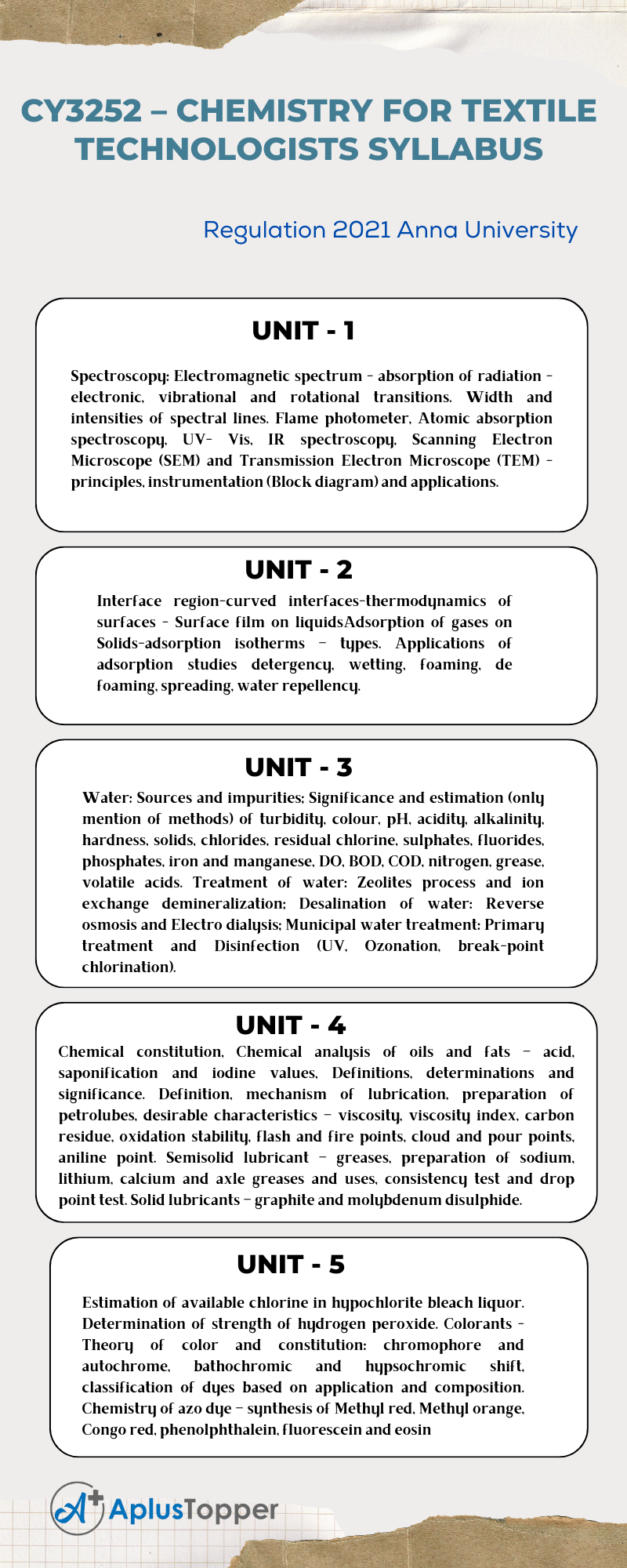Anna University Textile Chemistry syllabus of B. Tech. Textile Chemistry Semester II. In this article, we are glad to provide the syllabus of the Chemistry for Textile Technologists.
We aim to provide the following semester II CY3252 – Chemistry for Textile Technologists syllabus in a detailed manner. We include the appropriate syllabus textbooks and references. Hope this information is useful. Don’t forget to share with your classmates.
If you want to know more about the B. Tech. Textile Chemistry Syllabus is connected to an affiliated institution’s four-year undergraduate degree program. We provide you with a detailed Year-wise, semester-wise, and Subject-wise syllabus in the following link B. Tech. Textile Chemistry Syllabus Regulation 2021 Anna University.
Aim Of Objectives:
The course aims to
- Gain proper understanding on spectroscopic and surface analytical techniques.
- Impart knowledge to students on the chemistry of surface and interfaces.
- Make students well versed on the chemical analysis of oils, fats, soaps & lubricants .
- Firmly establish a sound understanding on the student’s mind about chemicals and auxiliaries.
- Familiarize students with the identification and characteristics of dyes and their applications.
CY3252 – Chemistry for Textile Technologists Syllabus
Unit – I: Spectroscopic Techniques
Spectroscopy: Electromagnetic spectrum – absorption of radiation – electronic, vibrational and rotational transitions. Width and intensities of spectral lines. Flame photometer, Atomic absorption spectroscopy, UV- Vis, IR spectroscopy, Scanning Electron Microscope (SEM) and Transmission Electron Microscope (TEM) – principles, instrumentation (Block diagram) and applications.
Unit – II: Chemistry Of Interfaces
Interface region-curved interfaces-thermodynamics of surfaces – Surface film on liquidsAdsorption of gases on Solids-adsorption isotherms – types. Applications of adsorption studies detergency, wetting, foaming, de foaming, spreading, water repellency.
Unit – III: Water Technology
Water: Sources and impurities; Significance and estimation (only mention of methods) of turbidity, colour, pH, acidity, alkalinity, hardness, solids, chlorides, residual chlorine, sulphates, fluorides, phosphates, iron and manganese, DO, BOD, COD, nitrogen, grease, volatile acids. Treatment of water: Zeolites process and ion exchange demineralization; Desalination of water: Reverse osmosis and Electro dialysis; Municipal water treatment: Primary treatment and Disinfection (UV, Ozonation, break-point chlorination).

Unit – IV: Oils, Fats, Soaps & Lubricants
Chemical constitution, Chemical analysis of oils and fats – acid, saponification and iodine values, Definitions, determinations and significance. Definition, mechanism of lubrication, preparation of petrolubes, desirable characteristics – viscosity, viscosity index, carbon residue, oxidation stability, flash and fire points, cloud and pour points, aniline point. Semisolid lubricant – greases, preparation of sodium, lithium, calcium and axle greases and uses, consistency test and drop point test. Solid lubricants – graphite and molybdenum disulphide.
Unit – V: Chemicals And Auxiliaries
Estimation of available chlorine in hypochlorite bleach liquor. Determination of strength of hydrogen peroxide. Colorants – Theory of color and constitution: chromophore and autochrome, bathochromic and hypsochromic shift, classification of dyes based on application and composition. Chemistry of azo dye – synthesis of Methyl red, Methyl orange, Congo red, phenolphthalein, fluorescein and eosin
Text Books:
- Dhara S. S., “A Text Book of Engineering Chemistry”, 12thEd., S. Chand & Co. Ltd., New Delhi, 2016.
- Jain. P.C. and Monica Jain, “Engineering Chemistry”, Dhanpet Rai & Sons, New Delhi, 17th Edition, 2018.
- Shikha Agarwal, “Engineering Chemistry-Fundamentals and Applications”, Cambridge University Press, Delhi, 2019.
References:
- B.K. Sharma, “Industrial chemistry”, Krishna Prakashan Media (P) Ltd, Meerut, 2014.
- Shore J., “Colourants and Auxiliaries: 2nd Edition, Volume 1 & 2, Woodhead Publishing Ltd., 2002.
- Shenai V. A., “Chemistry of Dyes and Principles of Dyeing”, Sevak Publications, Mumbai, 1995.
- Trotman E. R., “Dyeing and Chemical Technology of Textile Fibres”, B.Y Publishing Pvt. Ltd., New Delhi, 1994.
Related Posts On Semester – II:
- HS3252 – Professional English – II
- MA3251 – Statistics and Numerical Methods
- BE3252 – Basic Electrical, Electronics and Instrumentation Engineering
- GE3251 – Engineering Graphics
Must Read:
